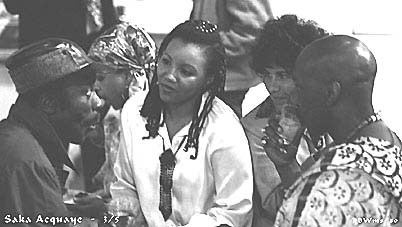Name Saka Acquaye | Books Obadzeng goes to town | |
 | ||
Saka acquaye and his african ensemble from ghana akudonno 1969
Saka Acquaye is a singer and textile designer from Accra, Gold Coast.
Contents
- Saka acquaye and his african ensemble from ghana akudonno 1969
- Akudonno
- Early life
- Career
- Awards
- References
Akudonno
Early life
Saka Acquaye was born 2 November 1923, the 6th child of his parents Regina and John Akweifio. He was educated in the Methodist School, Accra Royal School and then Government Boys Schools. He obtained a Cadbury Scholarship to enter Cadbury House, Achimota School. He washed dishes in the school’s dining hall, so he could have extra food, since his parents could not afford to supplement his meals.
While at college he became a champion hurdler, training without shoes using his own primitive hurdles made from tree branches. He became the captain of a squad of the National Athletic Team to represent the Gold Coast in 1950. He was Champion hurdler for the Gold Coast.
On completion of his course at Achimota, he taught for a couple of years at St. Augustine’s College in Cape coast, in the early 1950s.
Career
Wanting to pursue further studies in the United States, but with a bare pocket, Saka started creating textile designs which he sold to build his resources. At the time, he had founded the Black Beats Band much to displeasure of his father, who insisted that bandsmen were wayward and drunkards. To prove to him wrong, Saka would always put half of whatever amount of money he made from performances on table at which his father ate from, his father who always questioned where it was from. He loved and played the saxophone, flute and mouth organ and practiced till he achieved a harmonious blend of melodies. Saka vividly remembers how he always had to stuff the ends of his musical instruments with cloth to dull the sound whenever he had to rehearse at home. This was because he didn’t want to disturb anybody.
Saka Acquaye’s break finally came in1953 and he left the shores of the Gold Coast to pursue further studies at the Pennsylvania Academy of the Fine Arts. Here too, he has a number of stories to tell. Among them an accident in a factory, where he worked part-time like many other students in college. In his case, his finger got caught in a machine, which resulted in him losing a chunk of skin from his middle finger. Fortunately, he had a graft with skin from his thigh, leaving him with a big black scar, to remind him and us about his sojourn in the United States. In College, he shared a studio with a very rich white girl, who realized that Saka was a poor International student. For whatever reason, he would always refuse an offer from her to go out for a meal while working. His explanation to us was that even though he was starving, he didn’t want to be always the free gift, and not to be able to reciprocate the gesture. However, in spite of his turning down the offer the lady would every day, buy two packs of whatever meal she had, eat hers, put the other pack in the wastepaper basket and proceed to leave the studio for a while. Saka would then into the bin and polish off the second pack, which had been brought purposefully for him. This silent trade went on for a while.
Awards
As a student in Philadelphia, he scooped up awards. These include:
His local honours include a CSIR Gold Award 1979; Leisure Award-1988; ECRAG Flagstar Award 1993.
Career
He founded the African Ensemble while in the US and as its leader, recorded an album under the ELEKTRA Label. This group was up of American musicians. He also put together a group known as the African Tones. On his return from his studies in the United States to settle in Ghana, he met Mavis Amua-Sekyi of blessed memory. Acting was one of her hobbies. Therefore, Saka Acquaye gave her one of the leading roles in "Obadzeng", an opera he wrote. This drama piece so captivated Osagyefo Dr Kwame Nkrumah that he ordered a command performance and toured the Soviet Union with the play. Saka Acquaye had many plays to his credit including a book, "Problem of Creativity in Contemporary Africa" which he was hoping to launch. Saka Acquaye and Mavis got married on 4 August 1962. Saka Acquaye returned with his family to the United States to pursue further studies at the University of California, Los Angeles, UCLA. The many friends he met there include Maya Angelou, who was his neighbor on Sunset Strip. Saka Acquaye returned to Ghana and back to his busy life after this period of study. He directed the Wulomei, a Cultural Group for none years, touring Europe and the United States a couple of times and performing several times at the Art Centre among other venues. Today, the two big trees he planted in front of the Art Centre in Accra, are there as a reminder for us. Saka Acquaye has exhibited his work at home, in Nigeria, at the Royal Academy in London, in the USA and Japan. Some of his works of art can be found in the Banking Hall of the Bank of Ghana; the reception of the US Embassy; Ghana Commercial Bank, Tema Gordon Guggisberg’s Monument at the Korle-Bu; Busts of Guggisberg, Fraser and Achimota School; Dr J.B. Danquah Circle, Osu; In-laid paneling at Ghana Airways Offices in Cocoa House and in Lagos, Johnson Wax Conference Centre in Racine, Wisconsin, USA; the African American Heritage Association Lecture hall at Wayne University, Detroit, USA and Cambridge University among others.
